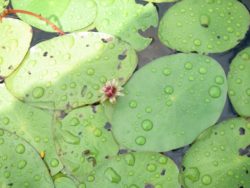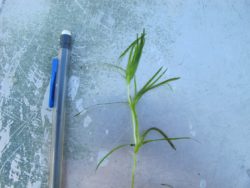by Jenifer Parsons
Note: This article originally appeared in the spring 2017 issue of Douglasia, the journal of the Washington Native Plant Society. It appears here with permission of the WNPS and our thanks. Learn more about this great organization at https://www.wnps.org/
I am very fortunate in that I spend a lot of time on Washington’s beautiful lakes and rivers looking at plants as part of my job. Most of the time I’m focused on finding invasive non-native weeds that cause problems. But, while out there I also take note of the native plants, and have come to regard several with particular fondness. Here are a few of these, illustrated with photos and a short explanation of what I find interesting about them.
Azolla, or water-fern. These are small free-floating plants with overlapping pairs of scale-like leaves and a root dangling down into the water. The taxonomy is confusing, but according to Evrard and Van Hove (2004), there are two native species, A. filiculoides and A. cristata. Microscopic examination of leaf and spore characteristics are needed to distinguish them, which I admit I have rarely tried since I’m always in a hurry to sample as many lakes as possible. Luckily, the one non-native invasive species (A. pinnata), has not been found in the Northwest and has a distinctive branching pattern resulting in a triangular outline, like a tiny Christmas tree. The native species have a more disorganized appearance.
Azolla spp. are ferns, which in itself is pretty interesting since there aren’t too many aquatic ferns. But on top of that it has a symbiotic relationship with its own blue-green algae species (Anabaena azollae) which live in small cavities at the leaf bases. The blue-green algae are really cyanobacteria. As such, they are able to fix atmospheric nitrogen, which they share with the fern. In exchange, the algae get shelter and mineral nutrients from the plant. This relationship gives Azollas a nutritional edge over other plants, and humans have taken advantage of this by using it as a green fertilizer in rice paddies and as a nutritional supplement in livestock feed. Recently, due to its proclivity for rapid growth and ease of cultivation, it has been investigated for its carbon-sequestering ability.
In large lakes Azolla is only found in protected marginal areas, but in small sheltered ponds it can grow profusely, covering the surface at times. It will turn red when stressed, and often is red in early spring in Washington, as can be seen from the Seattle-area wetland in the photo.
Brasenia schreberi, or water-shield, has floating leaves attached to rhizomes in the sediment by long purplish stems. The stems are slightly elastic so when the water surface becomes wavy the leaves can bob up and down without breaking off. The leaves are about 6 inches long and purple underneath. The leaves attach to the stem in the center of the leaf, like a shield or umbrella. In summer, small dark purple flowers bloom above the water surface.
The most interesting feature of this plant is the thick coating of gelatinous slime that covers stems and the underside of leaves, especially on young growth. This dense mucilage is secreted by special single-celled glandular hairs within the plant. It creates such a slippery surface that grabbing and holding onto the plant can be very difficult. Research has found the mucilage has excellent lubricating properties, with potential uses such as coating pills to ease swallowing (Li et al. 2012).
Spring growth of water-shield is eaten by people in Japan and China, and research has examined potential medicinal uses. It is also eaten by waterfowl and provides good shelter and habitat for fish and invertebrates. It also has been shown to have allelopathic properties which allow it to suppress the growth of other plants as well as green algae, and blue-green algae (Elakovich and Wooten 1987). As such, water-shield could help protect lakes from becoming green due to abundant algae growth
Najas or water-naiads are completely submersed plants. There are two main species in Washington, N. flexilis and N. guadalupensis (read on for the third). There are several interesting things about these plants. First, they are mostly annuals. Most aquatic plants are perennials and depend heavily on vegetative propagation. However, naiads have to make seeds, and complete pollination underwater. Fewer than 5% of aquatic plant species are water-pollinated, and even fewer do so completely underwater (others have pollen that floats on the surface to floating female flowers). The water-naiads accomplish this with abundant precocious pollen that forms tubes upon release. This effectively elongates the pollen, making it easier to encounter the elongate stigmas. They have separate male and female flowers, but both are present on the same plants. There is nothing that prevents self-pollination, so given the proximity of flowers to one another it is assumed a fair bit of self-fertilization takes place, though water currents and wave action would facilitate cross-pollination (Les 1988).
Another reason this plant is interesting is the recent taxonomic and genetic work that has found ‘cryptic sympatric speciation’ in the water naiads. This means that genetically distinct species that look nearly identical have evolved within one geographic area. In the naiads, this occurred sometime in the distant past when a N. guadalupensis x N. flexilis hybrid formed with both sets of chromosomes from both parents, forming a tetraploid new species that could not cross back with either parent. (Well, it can, but the progeny are triploid and sterile, and since it is an annual plant they die out quickly.) So, this tetraploid is called N. canadensis, and we happen to have that in Washington too (Les et al. 2015). All three of our species look very similar, and seeds are necessary for positive identification. Though if you have looked at many of them across a wide range, tentative identification to species is kind of a ‘gestalt thing’.
That is not all! Water naiads will also sometimes grow with striking profusion. These super-naiads are a conundrum for lake managers. They appear to be N. guadalupensis, which can be perennial, as they over-winter even under ice. They rarely seem to make seed, so identification without genetic analysis is back to that gestalt thing – not very reassuring when it is acting so invasive. This abundant growth occurs in other parts of the country, and seems to be on the increase, though genetic analysis indicates they aren’t a new hybrid or non-native species. So, is it climate change or increasing pollution that is causing the exceptional growth? Not sure! That is part of the fun and challenge of aquatic plants — there is so much yet to learn.
References
Elakovich, S.D., J.W. Wooten. 1987. An examination of the phytotoxicity of the water shield, Brasenia schreberi. Journal of Chemical Ecology. 13(9):1935-1940.
Evrard, C., C. Van Hove. 2004. Taxonomy of the American Azolla species (Azollaceae): a critical review. Syst. Geogr. Pl. 74:301-318.
Les, D.H., E.L. Peredo, U.M. King, L.K. Benoit, N.P. Tippery, C.J. Ball, R.K. Shannon. 2015. Through thick and thin: Cryptic sympatric speciation in the submersed genus Najas (Hydrocharitaceae). Molecular Phylogenetics and Evolution. 82:15-30.
Les, D.H. 1988. Breeding systems, population structure, and evolution in hydrophilous angiosperms. Ann. Missouri Bot. Gard. 75:819-835.
Li, J., Y. Liu, J. Juo, P. Liu, C. Zhang. 2012. Excellent lubricating behavior of Brasenia schreberi mucilage. Langmuir 28(20):7797-7802.













